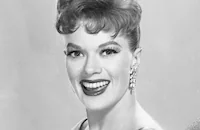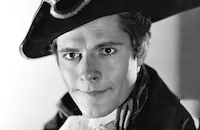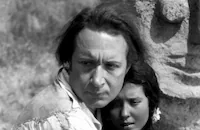The Time, the Place and the Girl

Brief Synopsis
Cast & Crew
David Butler
Dennis Morgan
Jack Carson
Janis Paige
Martha Vickers
S. Z. "cuddles" Sakall
Film Details
Technical Specs

Synopsis
On the day before the planned opening of their New York nightclub, Steven Ross and Jeff Howard are informed by musicians' manager Martin Drew, that his client, conductor Ladislaus Cassel, who lives next door, will prevent the club's opening because popular music is disturbing to Cassel and his granddaughter Victoria, an opera singer. Meanwhile, at the Cassel home, Cassel encourages Vicky to meet other men before she marries her fiancé, the stuffy Martin. Vicky decides to take his advice, and goes for a walk instead of taking the nap her grandmother Lucia, a former opera star, recommends. She accidentally meets Jeff and Steve, who have decided that one of them should romance Vicky and convince her to support the club. Vicky is charmed by Steve and introduces him and Jeff to her grandfather. On Steve's invitation, Vicky and Cassel attend the club's opening night, and Cassel reveals to Jeff's girl friend, singer Sue Jackson, that he has no objection to the club, but that Lucia and Martin, who are presently out of town, want it closed. Steve's attentions to the attractive Vicky disturb his current girl friend, Elaine Winters, even though she is busy cajoling Texas millionaire John Braden into supporting the club as a tax deduction. Later, after Vicky breaks her engagement to Martin, she discovers that he and Lucia have succeeded in closing the club. Believing that she will never see Steve again, Vicky is heartbroken, but Cassel, who dislikes Martin, tracks Steve down and reunites them. Now that the club is closed, Steve and Jeff have written a show that Elaine has persuaded Braden to back. Later, when Elaine sees Steve kissing Vicky, however, she announces that Braden has asked her to marry him and she will not let him back the show with "her" money. Cassel then offers to back the show, if they write a part for Vicky. Secretly, Cassel arranges for Lucia to sing in Mexico, accompanied by Martin. After she leaves, however, Cassel learns that Lucia has kept such a small sum of money in their joint account that he will not be able to pay the show's expenses. Elaine then returns, without having married Braden, and when she learns Cassel is broke, offers to back the show herself if Vicky drops out. Without telling Steve and Jeff, Vicky leaves the show, but on opening night, when Jeff, Steve and Sue learn the truth, they attempt to remove Elaine from the show through a ruse. Elaine discovers the trick, but then Braden comes backstage and tells Elaine he now has ten million dollars and still wants to marry her. He even offers to back the show if Steve and Jeff will release her from her contract. Vicky happily agrees to return to the show, but then Martin, acting as her manager, forbids her to appear. When Vicky defiantly refuses to quit, Lucia and Martin plot to close the show. After watching the first act, however, Lucia is charmed by the show, and informs Martin that Cassel, his most important client, will never appear under his management again if he prevents Vicky from performing. With Vicky as its star, the show goes on.

Director
David Butler
Cast

Dennis Morgan

Jack Carson

Janis Paige

Martha Vickers

S. Z. "cuddles" Sakall

Alan Hale

Angela Greene

Donald Woods

Florence Bates
Carmen Cavallaro
The Condos Brothers
Chandra Kaly
Mimi Aguglia

Lynne Baggett

Brandon Hurst
Chester Clute
George Floyd
Robert Wilbur

Monte Blue
Lillian Yarbo
Donald Davis
Vera Lewis
Bert Roach
Edward Kelly
Sada Brown
Richard Kipling
Jane Harker

Ramsay Ames
Tom Wells
Crew
Milo Anderson
Dudley Chambers
Gordon M. Davis
Leonard Doss
Arthur Edeson
Herbert Farjeon
Leo F. Forbstein
David Forrest
Alex Gottlieb
Ray Heindorf
Frederick Hollander
Agnes Christine Johnston
Natalie Kalmus
Bert Lawrence
Leonard Lee
James Leicester
E. Kenneth Martin
Frank Mattison
John Mitchell
Irene Morra
Thomas Morris
Leroy Prinz
Hugh Reticker
Leo Robin
Arthur Schwartz
William V. Skall
Lynn Starling
Francis Swann
Dolph Thomas
Robert Vreeland
Jack L. Warner
Perc Westmore
Howard Winterbottom

Videos
Movie Clip


Trailer
Film Details
Technical Specs

Award Nominations
Best Song
Articles
The Time, The Place and the Girl
Directed by David Butler, with a screenplay by Francis Swann, Agnes Christine Johnston and Lynn Starling, based on an original story by Leonard Lee, The Time, the Place and the Girl also had in its cast Janis Paige, Martha Vickers, S.Z. "Cuddles" Sakall, that long-time Warner Bros.' reliable Alan Hale and bandleader Carmen Cavallaro.
Shot in Technicolor on location in the desert resort town of Palm Springs, California, the Warner Bros. Burbank studios, and according to David Butler, a private home on Sunset Blvd., The Time, the Place and the Girl was another way for the company to get as much as they could out of Dennis Morgan, who had been elevated to star status in 1943 and was the highest paid actor in Hollywood two years later when this film was made. Once more, Morgan worked with his most frequent co-star, and close friend, Jack Carson, who he had known in their native Milwaukee. The two had toured together during the war and hung out together when they weren't working. Relative newcomer Janis Paige was appearing in her seventh film, and according to Butler, someone at the studio told her that she needed to lose weight. Paige took the advice too much to heart and required a blood transfusion, which was acquired by Butler's wife, who was working at the time for the Red Cross.
When it was released in December 1946, New York Times film critic Bosley Crowther called The Time, the Place and the Girl, "[A] hackneyed and mirthless affair in which a handful of farceurs and musicians clattered about for an hour and two-thirds. [...] [T]he combined and elaborate efforts of everybody, including LeRoy Prinz, who arranged the fancy stuff, have resulted in one of those pictures that you forget even while you're watching it." If The Time, the Place and the Girl was forgettable, it did introduce a hit song, A Gal in Calico by Leo Robin and Arthur Schwartz, which was a charting tune for Tony Martin.
SOURCES:
Butler, David and Atkins, Irene Kahn David Butler
Crowther, Bosley "The Screen" The New York Times 27 Dec 46
Gilpatrick, Kristin Famous Wisconsin Film Stars
The Internet Movie Database
http://www.tcm.com/mediaroom/video/141095/Time-The-Place-and-The-Girl-The-Original-Trailer-.html
By Lorraine LoBianco

The Time, The Place and the Girl
Quotes
Trivia
Notes
A 22 March 1945 Hollywood Reporter news item noted that Janis Paige replaced Jane Wyman, who was recovering from pneumonia. An undated press release announced that Ann Sheridan would appear in the film. Arthur Schwartz and Leo Robin's song "A Gal in Calico" was nominated for an Academy Award for Best Song.















